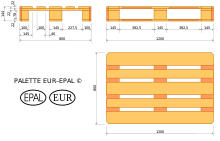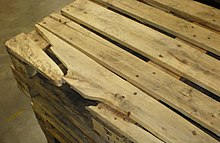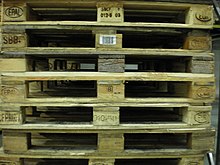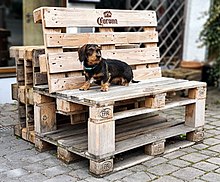Euro pallet
|
|
DIN EN 13698 |
|---|---|
| Area | Transportation |
| title | Product specification for pallets - Part 1: Manufacture of 800 mm × 1200 mm flat wooden pallets; Part 2: Manufacture of 1000 mm × 1200 mm flat wooden pallets |
| Latest edition | 2004-01, 2009-10 |
| ISO | - |
A EUR-pallet (colloquially Euro pallet ) is a flat pallet (FP) of wood from the exchange system of the Euro pools .
properties
Typically (as in the following) the reusable transport pallet standardized according to EN 13698-1 with a floor area of 0.96 square meters (0.4 loading meters ) and the dimensions 1200 mm × 800 mm × 144 mm (length × width × height) and A dead weight of 20 to 24 kg (depending on the wood moisture) is meant. It consists of eleven boards and nine blocks and is held together by exactly 78 special nails . The Euro pallet is UIC standardized and complies with the provisions of the European Pallet Association (EPAL).
The pallet has defined bevels on the four vertical outer edges to prevent it from getting stuck when maneuvering in tight holds. Between the nine blocks, the three floor boards have bevels in some places to make threading with forks or rolling in with a pallet truck easier. All bevels protect the wood from chipping.
A Euro pallet is a four-way pallet; it can be picked up and transported from all four sides with an automatic floor conveyor , for example a forklift or a pallet truck.
Wooden pallets entering the EU from non-member countries must be heat-treated. The pallets are placed in a room at 56 ° Celsius for 30 minutes in order to denature proteins and thus render them ineffective.
17 types of wood are approved by EPAL. "They are inexpensive and contain tannic acids that kill germs and thus have an antibacterial effect." The blocks are made of pressboard , which contains almost no moisture and is not susceptible to mold.
History of the Euro pallet
Early 1961 and in the following years, signed a number of European railways, the Association of International Railways (UIC) (Union Internationale des Chemins de fer) are organized, an agreement on the exchange of a variety called Euro pallet . At the end of 1968, some railways signed another contract for an exchangeable lattice box called the Eurogitterbox. The undersigned railways were obliged to adhere to the standards for the manufacture and repair of Euro pallets and Euro box pallets. The monitoring and the guarantee for the trouble-free exchange in the EPP (European pallet pool) was contractually agreed.
In the mid-1970s, the Deutsche Bundesbahn transferred its rights to the DB , RAL-RG 993 , oval EUR and EPAL symbols on the Euro pallets and Euro pallet boxes “Gütegemeinschaft Paletten” to today's European umbrella organization EPAL and the symbols were thus protected under trademark law.
There are now four different brands (WORLD, EPAL, CHEP , LPR ) that are legally registered and under which Euro pallets are manufactured. All of them are wooden pallets, the constructional structure of which is what the user commonly calls the "Euro pallet". The state of the art was published in the utility model of Julius Hofer ( Erbach ) from the German Patent Office under the number DE 1 935 973 U1 (Annex 1) on March 31, 1966.
The above-mentioned pallet design is manufactured under various brand names in standardized sizes in accordance with EN 13698-1 and is usually offered on the market in the 800 mm × 1200 mm pallet format, which consumers call "Euro pallets".
Since August 1, 2013, the EPAL label has to be in an oval on all edge blocks so that the pallet can be recognized as an EPAL pallet. The EUR lettering was omitted.
use
Euro pallets are used to optimize space utilization in transport. Swap bodies , swap bodies or articulated trucks offer 2.40 meters of usable loading width, which corresponds exactly to two euro pallets across or three euro pallets lengthways. A wide variety of goods can be loaded onto Euro pallets to save space. Euro pallets are therefore used everywhere in the transport industry. In many industrial companies, the packaging machines on Euro pallets are standardized.
As a rule, Euro pallets are not used in ISO containers because the dimensions of the Euro pallet do not match those of the ISO container, meaning that valuable transport volume in the container remains unused. Plastic or compressed wood pallets of types F11 and F76 with dimensions optimized for containers are used for this.
| designation | Measure | Maximum pallet load in an ISO 20 'container |
|---|---|---|
| F11 | 1140 mm × 1140 mm or 1135 mm × 1135 mm | 10 |
| F76 | 760 mm × 1140 mm | 15th |
In order to be able to transport conventional Euro pallets (1200 mm × 800 mm) in containers without losing loading space, special inland containers have been introduced for European inland traffic , which are based on the dimensions of the ISO containers, but are slightly wider.
Labelling
A Euro pallet from the EPAL system must have the following markings in order to be treated as such:
- Left and right blocks (viewed from the longer side)
- The EPAL marking in an oval border (EPAL = European Pallet Association e.V.)
- Middle log
- Identification of the company with a border e.g. B. "DB" for Deutsche Bahn AG
- Country of manufacture z. B. "DE" for Germany
- Quality test bracket (under the DE) and, if necessary, repair nail (if the pallet has already been repaired)
- Digits: number of the manufacturer - year of manufacture - month of manufacture
- IPPC marking for pest-free wood (important for export)
The marking is usually done by branding in wood. Before August 1, 2013, the right corner block had the symbol of the European pallet pool EUR instead of EPAL, also in an oval.
Below are a number of country codes that are used in Europe .
| Country code | Country of Manufacture |
|---|---|
| A. | Austria |
| B. | Belgium |
| BG | Bulgaria |
| BIH | Bosnia and Herzegovina |
| BY or GUS | Belarus |
| CH | Switzerland |
| DE | Germany |
| E. | Spain |
| F. | France |
| GB | Great Britain |
| GR | Greece |
| H | Hungary |
| MR | Croatia |
| I. | Italy |
| IRL | Ireland |
| LT | Lithuania |
| LV | Latvia |
| NL | Netherlands |
| PL | Poland |
| PT | Portugal |
| RO | Romania |
| RUS | Russia |
| SK | Slovakia |
| SZ | Slovenia |
| TR | Turkey |
| UA | Ukraine |
Weight loads on a euro pallet
The EUR flat pallet can carry a maximum of 1000 kg on one point and a maximum of 1500 kg if distributed evenly. Damaged and therefore non-exchangeable pallets often have a significantly lower load capacity. "The structure is robust enough to withstand falls and to be run over by a forklift with a weight of 4 t."
Differences in quality
A distinction is made between different types of quality when exchanging Euro pallets, which are decisive for the respective sender:
New Euro pallet:
- Delivered directly from the manufacturer to the customer. Common in the food industry as well as for pharmaceuticals and other goods sensitive to pollution.
New Euro pallet:
- Euro pallet that was involved in a maximum of two exchanges. This is common for industrial companies that have standardized their packaging machines on Euro pallets. Among other things, no wood splinters should stick out or be missing from the Euro pallet.
Used / exchangeable Euro pallet:
- Euro pallet that already has some defects due to frequent use, such as darker wood color or small chips. This type is used by most companies and shipping companies .
Used / no longer exchangeable Euro pallets:
- Refers to a rotten or broken Euro pallet.
Repaired Euro pallets:
- Europallets that can no longer be exchanged are repaired by companies registered and licensed by EPAL. Euro pallets repaired in this way fall into the category used / exchangeable . You can recognize repaired Euro pallets by a round nail seal in the middle block , which is issued exclusively by EPAL.
In practice, the evaluations differ from one another, in particular between "exchangeable" and "not exchangeable", despite simple rules of distinction. The pallet market in Germany differentiates between new, 1st choice, 2nd choice Euro pallets of the EPAL brand.
Pallet exchange
Exchange criteria
It is defined whether pallets are "exchangeable". According to EPAL, pallets can not be exchanged if
- the pallet was not manufactured by a licensed company according to EPAL criteria,
- the EPAL or other markings on the blocks are missing,
- a board is missing,
- Boards are so damaged that several nail shafts are visible,
- a block is missing or damaged so that more than one nail shaft is visible,
- the general condition is very bad (rotten, dirty).
The regulations for the manufacture and repair of EPAL Euro pallets are extensive, including the position of the individual nails. Violations are regularly prosecuted under criminal and civil law. There are numerous counterfeit Euro pallets in circulation.
There is often talk of "flawless exchange pallets". Pallets that do not fully meet the EPAL criteria for exchangeability are also accepted as such.
Exchange agreements
The exchange of Euro pallets does not take place automatically. The following conditions are mandatory for an exchange agreement:
- It is a Euro pallet in accordance with the quality criteria .
- When placing the order, the sender refers to Euro pallets.
- The number of Euro pallets is noted on the shipping documents.
- The carrier commissioned by the freight forwarder confirms - usually on the shipping documents / delivery note - the number of Euro pallets accepted from the customer.
It should be noted that pallet exchange is not common in all countries; even within the EU it has not caught on in all member states. At the end of 2007, Swiss freight forwarders withdrew from the pallet exchange. There are currently six countries in today's Euro pallet exchange pool: France, the Netherlands, Austria, Belgium, Luxembourg and Germany. The pallet exchange is an individual agreement between the sender and recipient, there is no obligation to exchange (legal basis). An alternative to exchanging pallets is to resell the pallets.
Wear factor
In contracts between shippers and forwarders, a wear rate of 5% is generally applied in favor of the forwarder.
exclusion
Euro pallets can only be excluded from the exchange if
- Euro pallets are made available by the sender that do not meet the above criteria,
- The recipient does not have any Euro pallets in the above criteria,
- the recipient also bought these Euro pallets.
All of this must be noted on the shipping documents.
Exchange clauses
The Federal Association of Freight Forwarding and Logistics recommends two different clauses for the exchange process :
- Cologne pallet exchange: The Euro pallets are exchanged step by step, which means at the loading point and the unloading point, immediately. The shipper undertakes that the number of exchanged Euro pallets is also available for exchange at the recipient. This clause is mostly used in direct traffic .
- Bonn pallet exchange: Euro pallets are made available by the shipper up to a certain contingent and are not exchanged by the recipient either. This clause is mostly used in groupage traffic .
Price, production quantity
Euro pallets are traded at daily prices. The price depends on supply and demand as well as the condition and treatment of the pallet (e.g. pest-free according to IPPC). A distinction must be made between rental prices and deposits. In August 2011, the market value of a Euro pallet was around € 8.50, with an estimated 400 million units in circulation. For 2017, a price of around € 10 was given.
In Germany there are almost 440 pallet manufacturers who produced a total of 111 million pallets with a value of 900 million euros in 2018 (2016: 103 million, 2017: 111 million). According to the Federal Association for Wood Packaging, Pallets and Export Packaging (HPE), waiting times for the delivery of pallets were common in 2018 due to the increased demand due to the economic situation and the used pallet market was practically empty.
Other uses
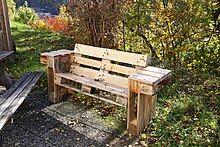
- Standardization, price and availability make Europool pallets interesting for architectural projects such as the “pallet house”.
- The gaps on the top of a Euro pallet are 40–43 mm wide and therefore narrower than the tires of trial bikes , which is why they are - usually screwed - suitable for building towers and obstacles.
- Due to their mostly worn-out appearance, the flexibility in use and the comparatively low price, Euro pallets are now increasingly used in the field of upcycling . Many artists rely on the Europool pallet, for example, to create furniture for indoor or outdoor use. In addition, the work with and the recycling of Euro pallets is considered to be very easy work, which is the reason for its increasing popularity. However, new pallets are now also expressly offered as material for their own designs or finished furniture is sold that is deliberately given the appearance of pieces made from pallets.
- At the end of the chain of use, there is the sawing of the nail-free areas for use as firewood, with iron nails falling on the grate or in the ashes.
See also
Web links
- Bonn pallet exchange procedure (German)
- Cologne pallet exchange procedure (German)
- Gütegemeinschaft Paletten e. V., German "branch" of EPAL
- European Pallet Association e. V.
- Bundesverband Holzpackmittel, Palletten, Exportverpackung e. V.
- Claudia Füssler: Alles paletti , in: Die Zeit , May 5, 2011 No. 19
- Lukas Weber: It's all paletti - wooden pallets are the all-purpose transport weapon in industry. Frankfurter Allgemeine Zeitung, July 3, 2015, accessed on January 25, 2016 .
- Godehard Weyerer: The measure of all things in logistics - the triumphant advance of the euro pallet. In: dradio.de , Deutschlandfunk, August 26, 2011
- Euro pallet exchange pool remains split. In: verkehrsrundschau.de , June 21, 2013
- Pallets: EPAL and UIC agree. The agreement on the uniform European pallet pool has been signed. VerkehrsRundschau, November 24, 2014, accessed on January 25, 2016 .
Individual evidence
- ↑ Triangular nailing with fluted, 90 mm long nails.
- ↑ EPAL pallet system. From EPAL-Pallets.org, accessed December 12, 2019.
- ↑ IPPC pallet - Why are Euro pallets handled? 2016. On Europaletten-kaufen.eu, accessed on December 12, 2019.
- ↑ Maple, acacia, aspen, birch, beech, sweet chestnut, oak, alder, ash, spruce, hemlock, pine, larch, poplar, plane tree, fir and elm
- ↑ Hans-Dieter Schramm: What wood are pallets made of? In: Ratgeber - General information on pallets and Euro pallets. June 18, 2019. From SchrammPalette.de, accessed December 12, 2019.
- ↑ a b c The wooden backbone of logistics . In: VDI-nachrichten, September 13, 2019, No. 37, p. 14.
- ↑ History of the Euro pallet , accessed on August 11, 2020.
- ↑ Utility model DE000001935973U German Patent and Trademark Office, accessed on August 11, 2020.
- ↑ What is EPAL? ( Memento of the original from November 26, 2015 in the Internet Archive ) Info: The archive link was automatically inserted and not yet checked. Please check the original and archive link according to the instructions and then remove this notice. , European Pallet Association eV
- ↑ a b pallets 1140 x 1140 mm. In: plastic pallets. At Transoplast.de, accessed on December 12, 2019.
- ↑ a b c INKA pallets: container pallets . INKA Paletten GmbH. Retrieved February 23, 2020.
- ↑ a b c Palettes en bois moulées - ORTH SA Fabrication de palettes en Alsace et Lorraine ( French ) Charles ORTH SA. Retrieved February 23, 2020.
- ↑ Product data sheet (PDF; 335 KB) at EPAL , accessed on April 5, 2017 (not available on December 12, 2019) .
- ↑ Left: IPPC symbol / PT: from Portugal; 6923: registration no. / EPAL / HT test clamp: Heat treatment / 015 7-05: Manufactured in May 2017 by company "015" / No repair to date because the test nail is missing.
- ↑ Euro pallet - Warehouse & Logistics Wiki. Retrieved May 9, 2018 .
- ↑ with identification federal state
- ↑ Quality classification for the open pallet exchange pool (04.12.2014). (No longer available online.) EPAL, archived from the original on January 25, 2016 ; Retrieved January 25, 2016 . Info: The archive link was inserted automatically and has not yet been checked. Please check the original and archive link according to the instructions and then remove this notice.
- ↑ Exchange criteria for Euro pallets - in the European pallet pool. GPAL, accessed January 25, 2016 .
- ↑ Pallets with the WORLD label are not exchangeable in the EPAL Euro pallet pool. GPAL, accessed January 25, 2016 .
- ↑ User information on this. (No longer available online.) GPAL, archived from the original on January 25, 2016 ; Retrieved January 25, 2016 . Info: The archive link was inserted automatically and has not yet been checked. Please check the original and archive link according to the instructions and then remove this notice.
- ↑ ASTAG is sticking to the pallet exit, but offers the shipping industry alternatives! ASTAG, accessed July 30, 2014 .
- ↑ Godehard Weyerer: The measure of all things in logistics. The triumph of the Euro pallet. Deutschlandfunk , broadcast on August 26, 2011.
- ↑ Paletten , In: Transportbranche.de
- ↑ Pallets in Germany are just accessed orf.at, January 7, 2018, January 7, 2018.
- ↑ BMVIT : Pallets never pall - Development of the Pallet House to series-production readiness (accessed on April 18, 2015).

